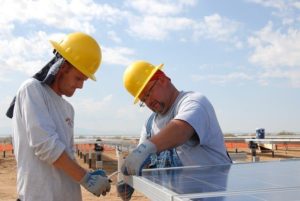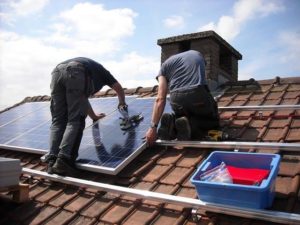Advancing technology and environmental pressures are likely to significantly increase demand for solar panel installations in Pennsylvania in the coming decade.
Although our state doesn’t rank in the top league for sunshine in the US, we have ambitious solar targets to eventually reach at least 10% penetration of Pennsylvania’s energy generation.
Longer term, its full potential could be as high as nearly one third of all the state’s energy requirements.

Earlier this year, Pittsburgh’s City Paper, reported that growth in solar industry jobs here is now outpacing other energy industries. In fact, while solar industry jobs nationwide fell by 3.2% last year, Pennsylvania’s take-up jumped 10%.
This has resulted in a shortage of skilled labor, which turns out to be just one of the major business risks now being faced by the industry in our state. But it’s far from the only risk.
How to Identify and Avoid Solar Panel Installation Risks
Traditionally, installing solar panels has been regarded as a fairly high-risk area of contracting, especially in the residential market and other construction sectors with pitched roofing.
Installation hazards can include:
Defective Materials/Products/Installation: Third party manufacturers vary in their quality — and so do some subcontractors. The important requirement here is to enshrine your quality specifications within contracts that meet client requirements and industry standards, and to ensure suppliers and subcontractors are themselves adequately insured and indemnified.
A quality control program is also essential for your own protection and reputation. Even with the highest standards, it’ still possible for defects to slip by without rigorous oversight.
Another hazard is the risk of mold collecting in roofing areas due to panel leakage, inadequate sealing, or trapped rain. Again, this can be obviated through quality control inspections.
Bodily Injury and Property Damage: Trips, slips and falls are a key cause of site injuries, as well as property damage arising from them. Documented safety training, site inspections and monitoring, and sanctions against rules disobedience can play a big part in reducing the number of incidents.
Compliance with industry standards such as the provision of guardrail systems, safety nets, anchorages and harnesses is vital. For more on this, please visit the OSHA site here.
It’s also important that installers and other ancillary employees wear appropriate protective clothing where necessary. Regulations require employers to conduct a personal protective equipment (PPE) assessment and respond accordingly — for example with the use of safety glasses, hard hats, gloves, respirators and so on.
However, these are not by any means the only source of damage or injury. Panels themselves, although fairly robust, become more vulnerable to damage while being handled on steep roofs and other difficult to access surfaces, as well as via crane and hoists. Again, rules for safe handling need to be documented.
A further risk is that a panel may fall and cause damage or injury sometime after installation. This emphasizes the need for strict quality checks. However, if panels are dislodged as a result, say, of a windstorm, this should be a matter for the client’s insurance.
Furthermore, as with all electrical contractor work, the risk of shocks, arc flashes and burns are an everyday hazard. These are covered in OSHA’s 29CFR (1910.269) standard which should be scrupulously observed, among others relating to the electrical industry.
In addition, installation employees and subcontractors are vulnerable to many of the hazards common to the construction industry — such as ladder safety and lifting techniques. A downloadable document produced by the state of Oregon provides useful guidance on solar panel installation safety. Find it here.

Equipment and Tools Loss or Damage: This is a risk that extends across most contracting services. Sanctions may be necessary against employees and subcontractors who are negligent. Theft is also a possibility.
Loss of tools or equipment can cause project delays. It’s prudent to ensure equipment is regularly maintained and inspected, and that spares of crucial items are held in reserve,
Weather Risks: Since solar panels are installed outdoors — whether on a rooftop or on a solar farm — workers are subject to the hazards of weather. Depending on the circumstances, this may involve heat or cold stress or stability risks from windstorms.
These risks can be minimized through a training program and by maintaining on-site monitoring of employees, looking out specifically for weather dangers or symptoms of dehydration, heat stroke and extreme cold. For more information on prevention techniques, review this OSHA document: https://tinyurl.com/OSHA-solar-heat
Insurance Exclusions: We discuss insurance in more detail below. But if you already have solar contractor insurance coverage, you should spend some time scrutinizing your policy.
This is because exclusions for specific events or hazards are not uncommon in this insurance sector. For example, some policies exclude loss of tools and materials onsite. Others exclude damage that may be caused to the building structure (especially the roof) while the project is underway.
You don’t want to discover this when it’s too late! Our specialists will be happy to review your commercial insurance policy and discuss this with you.
Protection: Solar Panel Contractor Insurance in Pennsylvania
Good risk management is key to the avoidance or mitigation of risk in the solar industry. Insurance protection against many of the risks outlined here is equally crucial. This can’t be stressed enough because even the most cautious contractor can still encounter some of these hazards.
In addition to what might be regarded as mainstream contractor insurance such as commercial liability, commercial auto and workers comp, special coverages can be added as either endorsements or separate policies, or relevant documentation.
These include:
- Performance and surety bonds and certification.
- Extended liability coverage for post-installation incidents.
- Employment practices liability insurance (EPLI).
- Premises and tools and equipment insurance.
- Inventory and materials in transit coverage.
- Mold protection against damage caused by unit leakage.
- Professional liability/errors & omissions (E&O) insurance for solar systems designers and consultants.
- Coverage for drones used in monitoring, surveying and inspection.
- Additional insured coverage.
- Custodial coverage relating to solar panel maintenance services.
- Obstruction of premises supplemental insurance (OOPS) for protection if an installation accident prevents an owner from accessing and using their building.
- Umbrella insurance to raise limits on liability coverage. Standard liability coverage ranges between $1m and $2m. Umbrella insurance can add up to $5m on top of this.
- Builders risk coverage to protect against business disruption caused by covered perils.

Why You Need an Expert
Because of the wide scope of risks in the solar panel contracting business — and the insurances that counter them — it’s important to discuss your specific activities with a knowledgeable agent.
A good agent should also be able to offer advice on how to minimize premiums, for example through implementing an advanced training and safety program and by having relevant industry certification.
They can also tell you which optional coverages you might also need.
In addition to advising you on these coverages, Robertson Insurance can provide guidance on solar contracting risk management, employee safety and OSHA compliance.
If you’d like to know more or to discuss these issues, contact our team of experienced insurance brokers.